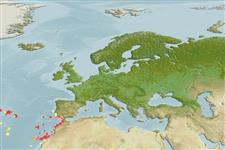Teleostei (teleosts) >
Gobiiformes (Gobies) >
Gobiidae (Gobies) > Gobiinae
Etymology: Lesueurigobius: From Charles Alexandre Leueur, painter that travelled with the scientific expeditons of Nicolas Baudin (1880-1804) in the ships "Géographe" and "Naturaliste" (Ref. 45335).
Eponymy: Charles Alexandre Lesueur (Le Sueur) (1778–1846) was a French naturalist, artist and explorer. [...] (Ref. 128868), visit book page.
Environment: milieu / climate zone / depth range / distribution range
Ecology
Marine; demersal; depth range 100 - 345 m (Ref. 4696). Subtropical
Eastern Atlantic: Off Morocco (31-34°N) and Madeira.
Size / Weight / Age
Maturity: Lm ? range ? - ? cm
Max length : 4.4 cm TL male/unsexed; (Ref. 4696)
Found offshore in the shelf and upper slope areas (Ref. 5299).
Life cycle and mating behavior
Maturity | Reproduction | Spawning | Eggs | Fecundity | Larvae
Miller, P.J., 1986. Gobiidae. p. 1019-1085. In P.J.P. Whitehead, M.-L. Bauchot, J.-C. Hureau, J. Nielsen and E. Tortonese (eds.) Fishes of the North-eastern Atlantic and the Mediterranean. Volume 3. UNESCO, Paris. (Ref. 4696)
IUCN Red List Status (Ref. 130435: Version 2024-1)
Threat to humans
Harmless
Human uses
Tools
Special reports
Download XML
Internet sources
Estimates based on models
Preferred temperature (Ref.
123201): 14.3 - 16, mean 15.4 °C (based on 7 cells).
Phylogenetic diversity index (Ref.
82804): PD
50 = 0.5312 [Uniqueness, from 0.5 = low to 2.0 = high].
Bayesian length-weight: a=0.00955 (0.00355 - 0.02566), b=3.03 (2.80 - 3.26), in cm total length, based on LWR estimates for this (Sub)family-body shape (Ref.
93245).
Trophic level (Ref.
69278): 3.2 ±0.3 se; based on size and trophs of closest relatives
Resilience (Ref.
120179): High, minimum population doubling time less than 15 months (Preliminary K or Fecundity.).
Fishing Vulnerability (Ref.
59153): Low vulnerability (10 of 100).
